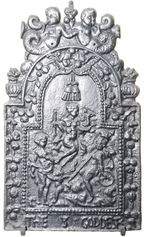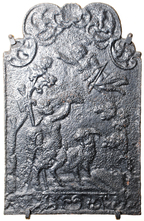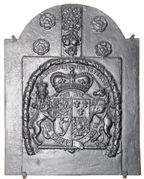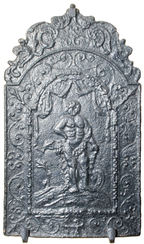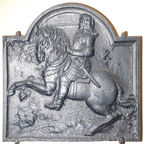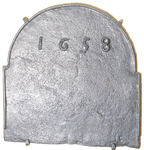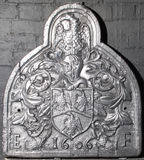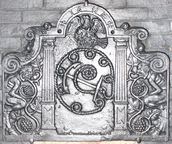-
520
Description: Arched rectangular central panel with bead edging; with tassel at top; three nude female figures: on top, Juno/Hera with a peacock, to the left Venus/Aphrodite, the young cupid/Eros at her feet, to the right Minerva/Athena with spear and shield; arched rectangular border with fillet edging; the heads of two putti and from them two suspended festoons of fruit and leaves; at the bottom, the inscription, THE 3 GODDESES, widely spaced. On top, two figures of Triton blowing seashells. On each shoulder of the fireback, a fluted vase with flowers issuing.
Notes: The three eponymous goddesses are those whose beauty was the subject of the Judgement of Paris. The composition is copied from an engraving by Adriaen Collaert (c1560-1618). This fireback is an instance of a continental back which has been recast in England, the opportunity being taken to insert an English inscription in place of the customary date and pattern maker's monogram. Mitford collection, Petworth House.
Copies of this fireback are known.
Inscription: THE 3 GODDESES [sic]
- Decoration tags:
- 'Dutch' (shape)
- fillet (edging)
- whole carved pattern
- planklines
- pictorial
- mythological
- text
Manufactured: in the late-17th century in England.
Current location: Petworth House, Petworth, West Sussex, England.
Museum number: NT/PET/M/74 (part of the National Trust museum group)
- Attached to series:
- 'Dutch' NDW series
- Judgement of Paris firebacks
-
521
Description: Rectangular with arched, mirrored scrolls on top and central scallop shell; fillet edging; Pan, with a goat behind, trees to left and right; a putto above right; at the bottom, a separate rectangular panel with mirrored scrolled foliage.
Notes: A scene apparently unrelated to a specific classical narrative, and without the customary decorated border. Mitford collection, Petworth House.
Copies of this fireback are known.
- Decoration tags:
- rectangular with ornate arch (shape)
- fillet (edging)
- whole carved pattern
- pictorial
- mythological
- animals
- humans
- plants
Manufactured: in the early-18th century in England.
Current location: Petworth House, Petworth, West Sussex, England.
Museum number: NT/PET/M/75 (part of the National Trust museum group)
- Attached to series:
- Late pictorial series (all)
- Late pictorial series 2
-
522
Description: Rectangular; cavetto-moulded edging; shield, helm, crest, supporters, mantling and motto of the Worshipful Company of Clothworkers: Sable a chevron ermine between in chief two Havettes Argent and in base a Teazel Cob Or; crest: on a Mount vert a Ram statant Or; supporters: two Griffins Or pellettée.
Notes: The arms as displayed were granted in 1587; the same fireback was also used as a stamp for a large fireback of 1659 in Haslemere Museum (no. 108). Mitford collection, Petworth House.
Arms: Worshipful Company of Clothworkers
- Decoration tags:
- rectangular (shape)
- cavetto (edging)
- whole carved pattern
- armorial
Manufactured: in the early- to mid-17th century possibly in the Weald area of England.
Current location: Petworth House, Petworth, West Sussex, England.
Museum number: NT/PET/M/76 (part of the National Trust museum group)
- Attached to series:
- Livery company firebacks
-
535
Description: Arched rectangular shape; no edging; raised central square surmounted by Royal Arms of Great Britain and Ireland, with Garter, crown and lion and unicorn supporters; surrounded by a horseshoe-shaped, twisted floral wreath, within which the inscription is printed in capitals. Above the arms a raised rectangular fillet is surmounted by two suspended floral swags, one above the other, comprising roses and oak apples. On each side of the fillet are two Tudor roses, one above the other.
Notes: Dated to between 1714 and 1801. The inscription is the visible part of an abbreviated version of the formal title of the monarch, ‘By the Grace of God, of Great Britain, France and Ireland, King, Defender of the Faith, Duke of Brunswick and Lünenburg, Arch Treasurer and Prince Elector of the Holy Roman Empire’. Mitford collection, Petworth House.
Copies of this fireback are known.
Inscription: MAG BRIT FRA ET HIB REX F D BRUN ET LUN DUX / HONY SOIT QUI MAL Y PENSE
Arms: English Hanoverian royal
- Decoration tags:
- rectangular with round arch (shape)
- none (edging)
- whole carved pattern
- armorial
- royal
- text
- plants
Manufactured: in the 18th century in England.
Current location: Petworth House, Petworth, West Sussex, England.
Museum number: NT/PET/M/89 (part of the National Trust museum group)
- Attached to series:
- Hanoverian royal armorial firebacks
-
537
Description: Arched rectangular central panel with bead-and-pellet edging on a broad fillet; nude figure of a man standing on a mound, resting his left hand on a club, a plant to his right, and drapery swags above; arched rectangular border with symmetrical swirls; monogram centre bottom; on top, symmetrical, swirled foliage.
Notes: The figure is probably of Hercules. The depiction may have been adapted from the image of the divine hero in 'Speculum Romanae Magnificentiae', a collection of engravings dated 1573 by Antonio Lafreri after Philippe Thomassin. Mitford collection, Petworth House.
Copies of this fireback are known.
Inscription: SHR
- Decoration tags:
- 'Dutch' (shape)
- fillet (edging)
- whole carved pattern
- pictorial
- mythological
- monogram
- text
- humans
Manufactured: in the late-17th to early-18th century in England.
Current location: Petworth House, Petworth, West Sussex, England.
Museum number: NT/PET/M/91 (part of the National Trust museum group)
- Attached to series:
- SHR series
- British 'Dutch' style firebacks
-
523
Description: Arched rectangular shape; cavetto-moulded edging; figure in mid-17th century armour, sword in belt, riding a prancing horse; initials split, below corners of arch, in front of horse’s head and behind rider’s back.
Notes: Probably intended to represent Charles I in memoriam, as other firebacks in this style date from the end of the Commonwealth period. Mitford collection, Petworth House. Copies of this fireback were advertised in the Wayte & Cheverton (Edenbridge) catalogue in the early-20th century, and inferior copies in Kings Worthy Foundry's (Winchester) catalogue in the mid-20th century.
Copies of this fireback are known.
Inscription: [C missing] R
- Decoration tags:
- rectangular with round arch (shape)
- cavetto (edging)
- whole carved pattern
- pictorial
- text
- animals
- humans
Manufactured: in the mid-17th century in the Weald area of England.
Current location: Petworth House, Petworth, West Sussex, England.
Museum number: NT/PET/M/77 (part of the National Trust museum group)
Citation: Baines, J. M., 1958, Wealden Firebacks (Hastings Museum).
Citation: Lloyd, N., 1925, 'Domestic Ironwork I', Architectural Review, 58, pp. 58-67.
- Attached to series:
- Small cavetto series
- Miscellaneous royal firebacks
-
532
Description: Arched rectangular shaped with narrow shoulders; fillet edging; date in individual numerals across arch.
Notes: A smaller version is different in the spacing of the numerals and the proportions of the plate. Mitford collection, Petworth House.
Inscription: 1658
- Decoration tags:
- rectangular with round arch (shape)
- rope (edging)
- carved stamps
- individual numbers
- text
Manufactured: in 1658 possibly in the Weald area of England.
Current location: Petworth House, Petworth, West Sussex, England.
Museum number: NT/PET/M/85 (part of the National Trust museum group)
- Attached to series:
- 1658 arched series
- Date only firebacks
-
583
Description: Arch-shaped, with rounded-arched extension at top; cavetto moulded edge all round; five vertical planklines; arms of the Francis (or Franceis) family of Derbyshire: Argent a Chevron gules between three Eagles displayed of the same; Crest: an eagle displayed on a crowned knight’s helm; initials in bottom corners; date below shield.
Notes: Probably the arms of Sir Edward Francis, who was Seneschal of the Petworth House estate and took overall charge in 1606 when the 9th Earl of Northumberland was committed to the Tower of London for his alledged involvement in the Gunpowder Plot.
Copies of this fireback are known.
Inscription: E 1606 F
Arms: Sir Edward Francis
- Decoration tags:
- arched with arch above (shape)
- cavetto (edging)
- whole carved pattern
- planklines
- armorial
- text
Manufactured: in 1606 probably at Frith Furnace, Northchapel in the Weald area of England.
Current location: Petworth House, Petworth, West Sussex, England.
Museum number: NT/PET/M/41.1 (part of the National Trust museum group)
Citation: Gardner, J. S., 1898, 'Iron Casting in the Weald', Archaeologia, 56, 1, pp. 133-164.
- Attached to series:
- Personal armorial firebacks
-
584
Description: Of unique design; quasi-arched rectangular shape; ribbon border, curled on each side of the neck. Symmetrical arrangement of plant tendrils with acorns, oak leaves, pomegranates and other leaves across the rectangular base; above and centrally placed are the date, over which are the initials either side of a crescent moon, surmounted by an earl’s coronet.
Notes: The initials, H N, are thought to refer to Henry, 9th Earl of Northumberland, and the date to his release from the Tower of London following his 17 years’ imprisonment for alleged involvement in the Gunpowder Plot.
Copies of this fireback are known.
Inscription: H N / 1622
- Decoration tags:
- rectangular with round arch (shape)
- complex individual (edging)
- whole carved pattern
- heraldic
- text
- plants
Manufactured: in 1622 probably at Frith Furnace, Northchapel in the Weald area of England.
Current location: Petworth House, Petworth, West Sussex, England.
Museum number: 485698 (part of the National Trust museum group)
- Attached to series:
- Personal firebacks
- Petworth lettering series
-
585
Description: Central arched rectangular shape formed of fluted Ionic pilasters supporting a rounded arch, with fillet edging, bearing the date between two flower heads; beneath is a fouled anchor within a circlet of rope gathered into eight loops; a phoenix, its wings displayed and inverted, rises from the flames above the rope; mirrored outside each pilaster, a crouching, naked faun, facing inwards, disgorges a vine with bunches of grapes; above each faun a volute forms the top corner of the plate.
Notes: The decorative elements of this fireback have yet to be fully interpreted; the vines disgorged from the mouths of the fauns are related to the 'green man' tradition associated with woodland spirits and symbolising resurrection, the latter echoed by the phoenix, though in the form in which they appear on this fireback they may be a purely decorative device. By contrast, the cabled anchor is the badge of the Lord High Admiral who, in 1608, was Charles Howard, 1st Earl of Nottingham (previously Lord Howard of Effingham). A pastiche of this fireback, dated 1633, is also known (no. 1064).
Copies of this fireback are known.
Inscription: 1608
- Decoration tags:
- rectangular with canted top corners and round arch (shape)
- fillet (edging)
- whole carved pattern
- pictorial
- mythological
- text
- humans
- plants
- objects
Manufactured: in 1608 in the Weald area of England.
Current location: Petworth House, Petworth, West Sussex, England.
Museum number: NT/L/PET/M/117.1 (part of the National Trust museum group)
Citation: Lloyd, N., 1925, 'Domestic Ironwork I', Architectural Review, 58, pp. 58-67.
- Attached to series:
- Miscellaneous pattern firebacks
- Phoenix firebacks
